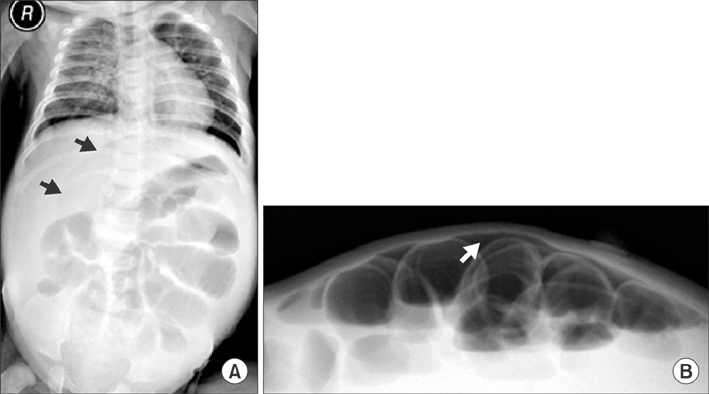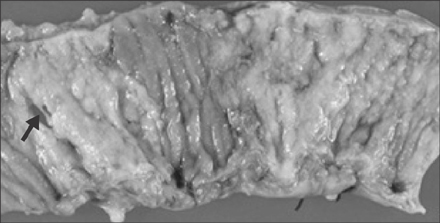Pediatr Gastroenterol Hepatol Nutr.
2017 Jun;20(2):130-133. 10.5223/pghn.2017.20.2.130.
Ileal Perforation with Norovirus Gastroenteritis in a 3-Month-Old Infant
- Affiliations
-
- 1Department of Pediatrics, Dongguk University Ilsan Hospital, Goyang, Korea. silbear@hanmail.net
- KMID: 2384827
- DOI: http://doi.org/10.5223/pghn.2017.20.2.130
Abstract
- Noroviruses have been recognized as the leading cause of epidemic and sporadic gastroenteritis since the advent of molecular diagnostic technique. They have been documented in 5-31% of pediatric patients hospitalized with gastroenteritis. Although norovirus gastroenteritis is typically mild and self-limited, it causes severe, but sometimes fatal, conditions in the vulnerable population such as immunocompromised patients, young children, and the elderly. Bowel perforation due to norovirus infection is rare. We report a case of small bowel perforation with norovirus gastroenteritis in the infant with Down syndrome during the hospitalization with pneumonia. Severe dehydration may cause bowel ischemia and could have triggered bowel perforation in this case. Physicians should be alert to the potential surgical complications followed by severe acute diarrhea, especially in high risk groups.
Keyword
MeSH Terms
Figure
Reference
-
1. Glass RI, Parashar UD, Estes MK. Norovirus gastroenteritis. N Engl J Med. 2009; 361:1776–1785.
Article2. Matthews JE, Dickey BW, Miller RD, Felzer JR, Dawson BP, Lee AS, et al. The epidemiology of published norovirus outbreaks: a review of risk factors associated with attack rate and genogroup. Epidemiol Infect. 2012; 140:1161–1172.
Article3. Mattner F, Sohr D, Heim A, Gastmeier P, Vennema H, Koopmans M. Risk groups for clinical complications of norovirus infections: an outbreak investigation. Clin Microbiol Infect. 2006; 12:69–74.
Article4. Patel MM, Widdowson MA, Glass RI, Akazawa K, Vinjé J, Parashar UD. Systematic literature review of role of noroviruses in sporadic gastroenteritis. Emerg Infect Dis. 2008; 14:1224–1231.
Article5. Bull RA, Tu ET, McIver CJ, Rawlinson WD, White PA. Emergence of a new norovirus genotype II.4 variant associated with global outbreaks of gastroenteritis. J Clin Microbiol. 2006; 44:327–333.
Article6. Mans J, de Villiers JC, du Plessis NM, Avenant T, Taylor MB. Emerging norovirus GII.4 2008 variant detected in hospitalised paediatric patients in South Africa. J Clin Virol. 2010; 49:258–264.
Article7. Johnston CP, Qiu H, Ticehurst JR, Dickson C, Rosenbaum P, Lawson P, et al. Outbreak management and implications of a nosocomial norovirus outbreak. Clin Infect Dis. 2007; 45:534–540.
Article8. Beersma MF, Schutten M, Vennema H, Hartwig NG, Mes TH, Osterhaus AD, et al. Norovirus in a Dutch tertiary care hospital (2002-2007): frequent nosocomial transmission and dominance of GIIb strains in young children. J Hosp Infect. 2009; 71:199–205.
Article9. Beersma MF, Sukhrie FH, Bogerman J, Verhoef L, Mde Melo M, Vonk AG, et al. Unrecognized norovirus infections in health care institutions and their clinical impact. J Clin Microbiol. 2012; 50:3040–3045.
Article10. Pawa N, Vanezis AP, Tutton MG. Spontaneous bowel perforation due to norovirus: a case report. Cases J. 2009; 2:9101.
Article11. Souza M, Azevedo MS, Jung K, Cheetham S, Saif LJ. Pathogenesis and immune responses in gnotobiotic calves after infection with the genogroup II.4-HS66 strain of human norovirus. J Virol. 2008; 82:1777–1786.
Article12. Pelizzo G, Nakib G, Goruppi I, Fusillo M, Scorletti F, Mencherini S, et al. Isolated colon ischemia with norovirus infection in preterm babies: a case series. J Med Case Rep. 2013; 7:108.
Article13. Turcios-Ruiz RM, Axelrod P, St John K, Bullitt E, Donahue J, Robinson N, et al. Outbreak of necrotizing enterocolitis caused by norovirus in a neonatal intensive care unit. J Pediatr. 2008; 153:339–344.
Article14. Ueda N, Shimotake T, Ohama K. Duodenal perforation associated with norovirus and rotavirus gastroenteritis. Clin Case Rep. 2013; 1:47–49.
Article15. Chen JC, Chen CC, Liang JT, Huang SF. Spontaneous bowel perforation in infants and young children: a clinicopathologic analysis of pathogenesis. J Pediatr Gastroenterol Nutr. 2000; 30:432–435.
Article16. Ballance WA, Dahms BB, Shenker N, Kliegman RM. Pathology of neonatal necrotizing enterocolitis: a ten-year experience. J Pediatr. 1990; 117:S6–S13.
Article17. Kusters MA, Verstegen RH, Gemen EF, de Vries E. Intrinsic defect of the immune system in children with Down syndrome: a review. Clin Exp Immunol. 2009; 156:189–193.
Article18. Verstegen RH, Kusters MA, Gemen EF, DE Vries E. Down syndrome B-lymphocyte subpopulations, intrinsic defect or decreased T-lymphocyte help. Pediatr Res. 2010; 67:563–569.
Article
- Full Text Links
- Actions
-
Cited
- CITED
-
- Close
- Share
- Similar articles
-
- Necrotizing Enterocolitis Associated with Norovirus Infection in a Preterm Infant
- Human Norovirus Genogroups Detected from Acute Gastroenteritis Patients in Seoul from May 2013 to April 2015
- Convulsions with Noroviral Gastroenteritis in Children at a Single Center in Korea
- Norovirus Associated Cerebellitis in a Previous Healthy 2-year-old Girl
- Comparison of Clinical Features of Norovirus and Rotavirus Gastroenteritis in Hospitalized Children and Norovirus Genotype Analysis



